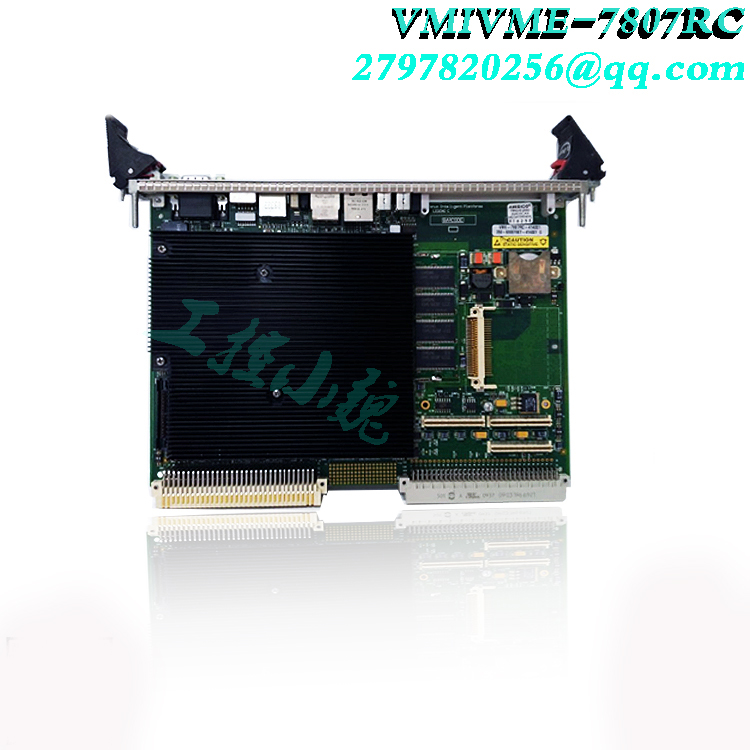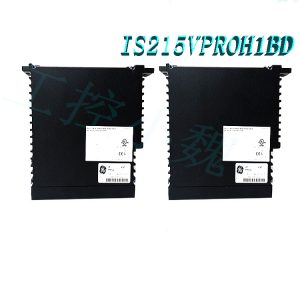Description
VMIVME-7807RC is a highly flexible single board integrated Intel Pentium M computer processor with up to 1.5 GB of DDR SDRAM and dual Gigabit Ethernet, with PCI-X and 66 MHz PMC expansion slots. The SBC operates at a frequency of up to 1.8 GHz, providing high bandwidth and high processing power, making it ideal for I/O intensive applications. Utilizing Intel’s new highly integrated 6300ECB I/O controller hub, VME-7807RC offers four serial ports, four USB 2.0 ports, serial ATA, IDE, and up to 2 GB of optional CompactFlash. This SBC utilizes Intel 855GME to provide SVGA DVI-I graphics support. Specification processing machine • Intel Pentium M @ 1.1 GHz, 1.4 GHz or 1.8 GHz • Good thermal performance • 2 Mbyte L2 cache (1.4 GHz and 1.8 GHz options), And 1 megabyte (1.1 GHz option) • 400 MHz system and memory bus SDRAM • Maximum memory configuration of 1.5 GB with optional ECC support DDR SDRAM Compact Flash • Can access up to 2 GB of CompactFlash auxiliary IDE ports • CompactFlash can be configured to boot devices through BIOS settings • V7807RC system BIOS and video BIOS provide Ethernet in programmable flash • Use Intel’s dual Gigabit Ethernet interface 82546EB, One port connected to the front panel and the second routed to P2 • Both Gigabit Ethernet ports can be routed to the optional P0 connector that supports VITA 31.1 • One 10/100 Mbit Ethernet port on the front panel using Intel 82551ER USB port • Four USB ports, Two connections to front panel 2 to P2 • Supported USB features include – isochronous data transfer – asynchronous messaging – self identification and configuration of peripheral devices – dynamic (hot) attachment V7807RC Intel Pentium(https://www.weikunfadacai1.com/)
M VITA 31.1 VMEbus single board computer VMEbus backplane interface • Tundra Universe II supports VME64 mode: A32/A24/D32/D08 (EO)/MBLT64/BLT32 serial ports • Four 16550 compatible serial ports – One RJ45 on the front panel – Three to P2 • Ports have independent 16 byte FIFO function, Supports baud rates up to 115 Kbaud • All ports can be configured for RS232/422 PMC expansion slots • One 5V PMC expansion site (IEEE 1386.1) programmable timer • Two 16 bit timers and two 32-bit timers • Maps to PCI memory space • Fully software programmable, Can generate PCI bus interrupt watchdog timer • Programmable interval • Interrupt and board reset trigger size • 6U (4HP) single slot European card form factor • Height 9.2 inches (233.4 mm) • Depth 6.3 inches (160 mm) • Thickness 0.8 inches (20.3 mm)(https://www.weikunfadacai1.com/)

VMIVME-7807/VME-7807RC complies with 6U VME physical specifications
Board VMIVME-7807/VME-7807RC can be used for system control or as a peripheral board. They can be directly inserted into any board that accepts any type. The following steps describe the installation and power on method of the recommended GE Fanuc embedded system VMIVME-7807/VME-7807RC:
1.If you want to use the PMC module, please connect it to VMIVME-7807/VME-7807RC before installing the board
2. Insert VMIVME-7807/VME-7807RC into the VME chassis system controller or peripheral slot. Ensure that the board is correctly aligned and oriented in the support plate guide rail, and slide the board forward to fit the connector. Use the ejector handle to securely secure the board.
3. All required peripheral devices can access the VMIACC-0586/ACC-0586RC or VMIACC-0590/ACC-0590RC Rear Transition Module (RTM) from the front panel or rear I/O. Each connector is clearly marked on the front panel with detailed pins in Appendix A.
4.If you have not connected to the system before, please connect the keyboard and mouse to configure it.
5.VMIVME-7807/VME-7807RC has optional CompactFlash disk board members. For detailed information on settings, please refer to Chapter 3
6.If an external drive module is installed, the drive type must be configured using the BIOS setup program. Please refer to Appendix B for proper system configuration.
7. If there is a driver module, please follow the manufacturer’s instructions.
.jpg)
BIOS Settings VMIVME-7807/VME-7807RC has an onboard BIOS settings program that controls many configuration options. These options are stored in a special non-volatile, battery supported storage chip, collectively referred to as the on board CMOS configuration. CMOS configuration control and hardware behavior from the moment power is applied. The detailed information of the VMIVME-7807/VME-7807RC BIOS setup program is included in Appendix B.
VMIVME-7807/VME-7807RC provides front panel channel stations for PMC expansion, an optional Gigabit Ethernet port, a 10/100 RJ45 connector, a serial port, SVGA, keyboard/mouse, manual reset switch, and status indicator lights. The front panel of drawing VMIVME-7807/VME-7807RC is shown in Figure 1-5. The labels for the front panel connectors and indicators are as follows:
VMIVME-7807/VME-7807RC provides backend I/O support for digital video, serial ATA, COM2, 3, and 4, IDE drives, and two USB ports. These signals are terminated to industry standard connectors using RTMs such as VMIACC-0586/ACC-0586RC and VMIACC-0590/ACC-0590RC. The definition for VMIVME-7807/VME-7807RC can be found in Appendix A. The rear panel connection is defined in the corresponding RTM installation guide. Contact sales to obtain compatible RTM provided by GE Fanuc embedded system.
VMIVME-7807/VME-7807RC is a computer that is compatible with modern industrial standard desktop systems based on the Pentium M processor. This VMIVME-7807/VME-7807RC therefore retains industry standard memory and I/O mapping, as well as standard interrupt architecture. The integrated peripheral devices described in this section (such as serial ports, USB ports, IDE drives, floppy drives, video controllers, and Ethernet controllers) are all compatible with desktop systems with similar configurations to ensure compatibility with modern operating systems. The following section introduces VMIVME-7807/VME-7807RC.
The VMIVME-7807/VME-7807RC CPU is shipped with a Pentium M processor. The CPU speed and memory/CompactFlash size are specified by the user as part of the VMIVME-7807/VME-7807RC ordering information. VMIVME-7807/VME-7807RC provides DDR synchronous DRAM (SDRAM) as onboard system memory. Memory can be accessed in the form of bytes, words, or long words. VMIVME-7807/VME-7807RC accepts optional solder from a 200 pin DDR SDRAM SODIMM 512MB onboard memory, with a maximum capacity of 1.5GB. On board DRAM can access VME through PCI to PCI bridge and can be addressed by local processors.
VMIVME-7807/VME-7807RC includes SMSC Super I/O (SIO) chips. This SIO provides two 16550 UART compatible serial ports, keyboard, and mouse ports for VMIVME-7807/VME-7807RC. The keyboard and mouse interfaces can be accessed through the front panel using standard PS/2 connectors. COM1 passes through the front panel. COM2 routes to VME P2 connector. COM ports 3 and 4 are also routed to the VME P2 connector by the 6300ECB I/O controller hub. The parallel IDE interface is provided by the Intel 6300ECB I/O controller hub. This IDE interface supports two channels: the main channel and the auxiliary channel. Secondary channel onboard routing to optional CompactFlash sockets. The main channel has been routed from the VME P2 backplane connector to the RTM, which terminates at the standard 40 pin plug. This channel can support both master and slave drives. The IDE interface is on VMIVME-7807/VME-7807RC and supports Ultra ATA/33, Ultra ATA/66, and Ultra ATA/100 drives, depending on the type of drive used. In order to function properly in Ultra ATA/100 mode, a special 80 conductor cable must be used instead of the standard 40 conductor cable. This cable is usually available from Ultra ATA/100 drive manufacturers. The serial ATA driver interface is also provided by the 6300ECB I/O controller hub. This serial ATA port can be used alone or in combination with a parallel IDE interface
.jpg)
Ethernet controller
The network functionality is provided by Intel 82546EB for VMIVME-7807 or Intel 82546GB for VME-7807RC Ethernet controllers, for Gigabit Ethernet and Intel 82551 10/100 Mbit Ethernet. These Ethernet controllers are software configurable based on the PCI bus. VMIVME-7807/VME-7807RC supports 10BaseT, 100BaseTX, and 1000BaseT Ethernet. 10BaseT is a network based on the 10BaseT standard that uses unshielded twisted pair cables, allowing the use of existing telephone lines and connectors. The maximum length of standard 10BaseT when using RJ45 connectors with 10BaseT is 100 meters. 100BaseTX VMIVME-7807/VME-7807RC also supports 100BaseTX Ethernet. The network is based on the 100BaseTX standard, using unshielded twisted pair and RJ45 connectors. The maximum length of 100BaseTX is 100 meters. 1000BaseT VMIVME-7807/VME-7807RC supports the use of Intel 82546EB for VMIVME-7807 or Intel 82546GB for VME-7807RC dual Ethernet controllers. The interface uses shielded cables with four pairs of conductors, as well as RJ45 connectors on the front panel or routed to VME P2 connectors. Gigabit Ethernet can also be paired with the optional VITA 31.1 from the optional P0 connector
Digital Video Interface (DVI)
VMIVME-7807/VME-7807RC has a digital visual interface that provides high-speed digital connectivity for visual data types used in display technology. Independent DVI is designed for digital flat panel displays. In most cases, these displays are currently connected to an analog video graphics array (VGA) interface, so dual conversion is required to convert the digital signal from the computer to an analog VGA interface, and then convert it back to the digital signal from the flat panel display. This inherent inefficient process can affect performance and video quality, and increase costs. On the contrary, when a flat panel display is connected to a digital interface, there is no need for analog-to-digital conversion. DVI uses PanelLink from Silicon Image, a high-speed serial interface that uses Transition to minimize differential signals (TMDS) and send data to the monitor. DFP and VESA plug and play interfaces also use PanelLink. Therefore, DVI can work by using adapter cables (depending on the quality of the signal adapter). DVI also supports VESA Display Data Channel (DDC) and Extended Display Identification Data (EDID) specifications. DDC is a standard communication channel between display adapters and displays. EDID is a standard data format that includes monitor information such as supplier information, monitor timing, maximum image size, and color characteristics. The EDID information is stored in the display and communicated through DDC. EDID and DDC enable system, display, and graphics adapters for communication, so that the system can be configured to support specific functions available in the display. The DVI connector has 24 pins and can accommodate up to two TMDS links and VESA DDC and EDID services. The DVI specification defines two types of connectors (see Figure 1): • DVI Digital (DVI-D) only supports digital displays (for VMIVME-7807/VME-7807RC) • DVI Integrated (DVI-I) supports digital displays and is backward compatible with analog displays (not supported) VMIVME-7807/VME-7807RC uses a DVI-I connector with a single TMDS link. The DVI-I interface can accommodate 12 or 24 pin DVI plug connectors or new analog plug connectors, using four additional pins and a ground plane plug to maintain a constant impedance for analog RGB signals.
Model recommendation:



.jpg)
.jpg)
-300x300.jpg)

-300x300.jpg)
angel –
GE VMIVME-7807 | VMIVME-017807-414001 | 350-0001007807-414001D. General Electric VMIVME-7807, also known as VMIVME-017807-414001 and 350-0001007807-414001D, are the same product name, which is General Electric’s Variable Frequency Drive (VFD).
Variable frequency drive (VFD) is used to control electric motors, reduce energy consumption, and improve efficiency. They allow precise control of the motor’s speed by changing the frequency of the power supplied to the motor. (Click to view related products: VMIVME-7750, VMIVME-7614)
GE VMIVME-7807 is a three-phase VFD with a rated power of 780 kW. It operates within the temperature range of -40 to+85 ° C and is designed specifically for hazardous location applications.
This VFD has the following functions:
Direct Digital Control (DDC) for precise speed control
Modbus RTU and ASCII communication protocol
Built in diagnostic and protection functions
A wide operating range from 50 Hz to 60 Hz.